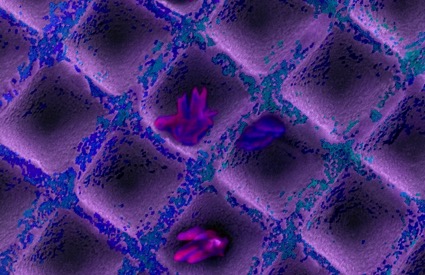The potentiality of BCs for the preparation of nanomaterials have been widely recognized since the 90’s but only partially explored, and the investigations carried out within the group have the aim to give a contribute for a better comprehension and control of such systems.
In particular, our attention is actually focused on the following topics:
BC nanocomposites with special electro-optico-magnetic properties. Nanocomposites based on BCs as nanostructured matrices with metal or magnetic nanoparticles as fillers are very attractive materials mainly due to their potential applications in many sectors such as molecular electronics and photonics or to produce advanced sensoring systems, especially in the case of controlled spatial distribution of the nanoparticles into the matrix and collective behavior. This project has the aim of contributing to a better comprehension of such systems and tuning methods that use BC thin films (bidimensional, 2D) with well-ordered and oriented morphologies (superlattices) or tridimensional (3D) matrices with colloidal templates that can eventually be converted into porous materials which could offer particular properties even at low nanoparticle concentration.
BCs in solution as nanoreactors. A different way to utilize BCs in order to facilitate the formation of hybrid organic/inorganic materials concerns the possibility to use the BC micellar core as nanoreactor where inorganic precursors may be load and then reduced to produce NPs. Such BC/NP hybrids have peculiar magnetic, optic and catalytic properties, offering at the same time new opportunities due to the BC self-assembly which permits, as an example, the ordered deposition of metallic clusters into a BC micellar monolayer.
Material science for Cultural Heritage
Nanotechnology for Cultural Heritage protection
Part of the group is actually involved in a recently funded European Commission – Horizon 2020 project, focused on “NANOmaterials for the REStoration of works of ART” (NANORESTART).
Contemporary art is a major challenge for conservators since there is a significant lack of established conservation methodologies that can safely tackle the often extremely fast degradation of materials used by contemporary artists. It may be said that many current modern and contemporary works of art will probably not be accessible to visitors/users in a hundred years due to rapid degradation, as they degrade beyond restoration.
Post-1940 artists and early artists (1880s-1940s), used and experimented with materials that are so radically different from the ones used in classic art, that they cannot be preserved using the currently available methodologies.
The conservation of this diverse cultural heritage requires advanced solutions at the cutting edge of modern chemistry and material science in an entirely new scientific framework that is now being be developed within NANORESTART project.
The NANORESTART project focus on the synthesis of novel poly-functional nanomaterials and on the development of highly innovative restoration techniques to address the conservation of a wide variety of materials mainly used by modern and contemporary artists. In NANORESTART, enterprises and academic centers of excellence in the field of synthesis and characterization of nano- and advanced materials have joined forces with complementary conservation institutions and freelance restorers. This multidisciplinary approach covers the development of different materials in response to real conservation needs, the testing of such materials, the assessment of their environmental impact, and their industrial scalability.
 Polymers and especially Block Copolymers (BCs) are an excellent tool for the preparation of nanostructured materials and more specifically for the controlled fabrication of functional nanocomposite materials. BCs may be defined as two or more chemically homogeneous polymeric fragments, i.e. homopolymeric chains, joined together by covalent bonds to form diverse and complex linear and non-linear architectures. In the frequent case of immiscibility among the constituent polymers, the competing thermodynamic effects give rise to different types of self-assembled morphologies depending on composition, segmental interaction and molecular weights, and having periodicity on length scales given by the polymer dimension itself. In the simplest case of amorphous diblock copolymers, the components may separate into regular arrays of lamellas, cylinders or spheres, while in solution spherical and cylindrical micelles or vesicles may be formed, therefore allowing to obtain in a simple manner and without any direct human intervention a large variety of highly regular mesostructures suitable for application in nanotechnology.
Polymers and especially Block Copolymers (BCs) are an excellent tool for the preparation of nanostructured materials and more specifically for the controlled fabrication of functional nanocomposite materials. BCs may be defined as two or more chemically homogeneous polymeric fragments, i.e. homopolymeric chains, joined together by covalent bonds to form diverse and complex linear and non-linear architectures. In the frequent case of immiscibility among the constituent polymers, the competing thermodynamic effects give rise to different types of self-assembled morphologies depending on composition, segmental interaction and molecular weights, and having periodicity on length scales given by the polymer dimension itself. In the simplest case of amorphous diblock copolymers, the components may separate into regular arrays of lamellas, cylinders or spheres, while in solution spherical and cylindrical micelles or vesicles may be formed, therefore allowing to obtain in a simple manner and without any direct human intervention a large variety of highly regular mesostructures suitable for application in nanotechnology.



